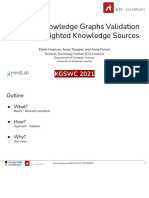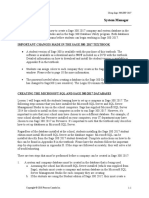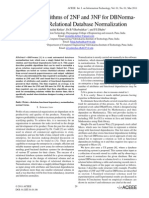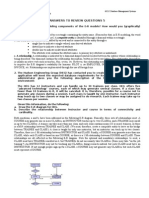Professional Documents
Culture Documents
Disaster Recovery Planning For Oracle Middleware Applications
Original Title
Copyright
Available Formats
Share this document
Did you find this document useful?
Is this content inappropriate?
Report this DocumentCopyright:
Available Formats
Disaster Recovery Planning For Oracle Middleware Applications
Copyright:
Available Formats
Volume 6, Issue 1, January – 2021 International Journal of Innovative Science and Research Technology
ISSN No:-2456-2165
Disaster Recovery Planning for Oracle
Middleware Applications
Ananthan Subburaj
Technology Architect
New Jersey, United States of America
Abstract— Disaster recovery planning is one of the most through tools and scripts as much as possible and the people
crucial component for a business but that is often ignored who are assigned.
or inadequately planned. Business organizations must
have a well-structured plan and document process for The DRO should have the well-defined procedures for
disaster recovery and business continuity, before a conducting recovery:
catastrophe occurs. The IT infrastructure disasters can be Notification and Initial workforce mobilization process
short term or long lasting failure resulting in loss of Damage assessment process
application and data, but when an organization is well Disaster declaration process
planned with standby infrastructure and recover plan in Secondary Workforce mobilization process
place, it can quickly get the business on track. This paper DR command center establishment process
will clearly outline the disaster recovery planning best DR support center establishment process
practices and technical process to recover the oracle Application recovery procedures
applications with zero data loss. This paper aims to
provide best practices for effective disaster management
III. DR RESOURCE PLANNING AND
planning and technical configurations to achieve faster
UTILIZATION
application recovery.
An alternate facility should be available to function as a
Keywords:- Disaster Recovery; High Availability, Fusion DR command & support center supporting the senior DR
middleware DR, DR planning. management and DR process teams along with operations,
help desk, workstation support and other virtual teams. This
I. INTRODUCTION facility should be available for use by IT operations,
application and business team personnel in order to allow
Today’s information world the IT applications have
them to perform their respective duties during a recovery
become increasingly critical for the operation of a company,
process and after the recovery process. Maintenance and
the importance of ensuring the continued operation and the
testing of facilities is on an annual basis to keep pace with DR
rapid recovery of IT applications has increased. The business
organization and recovery requirements:
organizations will be severely impacted by disaster when IT
infrastructure cannot continue to function due to data loss or A. Normal Mode
the application infrastructure failure, it may even go out of During normal day-to-day operations the D.R. hardware
business. An effective disaster recovery plan ensures quick resources can be used for Test, Development, and QA
recovery of data and application infrastructure in the event of activities with minimum allocation for the DR sync activities.
natural or technical disaster. This paper aims to provide
All the DR servers should be on active maintenance contracts
systematic approach to plan the disaster recovery organization with supplying vendors, and all code fix, firmware, and
level process and technology implementation technique to Operating systems should be kept up to date same level as
reduce the disaster recovery time for oracle middle primary Datacenter.
applications using the logical host names.
B. Test Exercise Mode
II. DISASTER RECOVERY ORGANIZATION The DR test can be done in two different options, one is
to switch over the primary to DR and run the business
In the event of a disaster, the objective of the Disaster
operations in the DR for specific window and then switch
Recovery Organization (DRO) is to minimize disruption and back to original primary, the second option is testing the DR
downtime of critical business functions and data loss by
facility in isolated network non-invasive to current production
rapidly recovering business critical infrastructure and
environment with controlled user testing.
application components. The DRO focuses on two metrics
Recovery Point Objective (RPO) and Recovery Time C. Disaster Evernt Mode
Objective (RTO). As the disaster recover work cannot be Actual DR event where all production application
planned and it is response to an unexpected event, the
systems are recovered in DR location and made available for
recovery process should be well documented and automated the business operations.
IJISRT21JAN615 www.ijisrt.com 1476
Volume 6, Issue 1, January – 2021 International Journal of Innovative Science and Research Technology
ISSN No:-2456-2165
IV. DISASTER RECOVERY ARCHITECTURE The Fusion middleware applications uses metadata
schema and application schemas in the oracle database.
The fusion middleware applications production based on Establish oracle physical standby database to replicate the
WebLogic server technology such as Webcenter Portal, data from production site to DR site. Configure the data guard
Webcenter Content, and Imaging and Identity Management broker to monitor and perform administrative tasks for the
products have product software binaries, domain configuration database replication.
file and application metadata schemas in the database. The
Fusion Middleware application disaster recovery includes V. NETWORK CONFIGURATIONS
application tier file system replication and the metadata store
database replication to the standby site. The recommended The application components should be configured using
process for the disaster recovery is to use the shared storage the logical hostname (host name alias) instead of physical
for all the application tier nodes in the production site and host name for the listen address on both WebLogic Admin
using storage replication to synchronize the application tier and managed servers. The logical host name should be
file systems to the standby site, replicate the database tier revolved to appropriate physical host IP address in primary
using the oracle physical standby database. site and also in the DR site. As the alias host name in
production site resolves to production host physical IP
address and in the DR site resolves to the DR host physical IP
address there is no need to update any domain configuration
when switching over to the standby site for disaster recovery
operation. Configuring the application components with alias
hostnames also helps with the server migration in the event of
any host hardware or operating system failure with the
production site, the application can be quickly started on
another server by mounting the shared application file
systems and updating the alias hostname to point to the new
server’s physical IP address.
The load balancer should be configured on both primary
and standby site to route traffic to the physical IP of the
servers. When the switch over happens the application DNS
should be change to connect to the DR load balancer virtual
IP address instead of the primary site load balancer virtual IP.
The site load balancer can be used to route traffic between
primary and standby site load balancers based on the health
check rules or on demand when the DRO declares the disaster
and the application switch over is completed.
The host name resolution can be achieved by using the
local /etc/hosts file on each application and database hosts
involved in the configuration or using the DNS servers. When
using the /etc/hosts file maintain the entry for all the
Fig. 1. Disaster Recovery Topology application servers with same set of entries for better
manageability. When using the separate DNS servers for
The middleware applications have oracle software primary site and DR site the alias host name alias entries can
binaries, domain configuration files, application deployment be preconfigured in the DNS appropriately to point to the
files and application metadata files in the application tier. The respective physical hosts. With global DNS server the
application tier mount points should be created with shared hostname alias need to be updated to point to the DR site
storage file system on the production primary site and install during the recovery process.
the application binaries on shared file system, when using
multiple mount points create all the mounts points from the The host name resolution process should be decided
same consistency group on the primary site to ensure part of the design phase of the DR process. The name
consistent data replication across all the file systems to resolution method can be controlled by changing the
standby site. Setup storage replication at the project level with configuration order in /etc/nsswitch.conf file on each host.
appropriate replication schedule. The recommended schedule The entry like (hosts: files dns nis) this makes the host to
for the binary and configuration files are once a day and one use the hosts file on the server as primary resolution method.
time on demand sync can be done whenever there is major
deployment or upgrade happens on the primary site. As the
file system replication and automatic scheduling of
incremental sync replicates all the changes in the primary site
to standby site and there is no need to install any software or
update configurations in the standby site.
IJISRT21JAN615 www.ijisrt.com 1477
Volume 6, Issue 1, January – 2021 International Journal of Innovative Science and Research Technology
ISSN No:-2456-2165
VI. MANAGING HOST NAME Execute the DNS change and validate alias host name
resolution to the appropriate standby site hosts.
Depending on the type of host name resolution used Start all the applications services on the standby nodes.
following are the sample host name alias required for the Update the application URL DNS to point to the standby
middleware applications. When using the /etc/hosts file based load balancer or use a global load balancer to route user
resolution make sure have entries for all hosts are maintained connections to standby site.
across all the servers part of the application topology and test If original primary site is accessible, ensure to enable the
the name resolution by using ping command from each node replication of both database and application file systems.
to all other nodes. The naming resolution should be validated Establish appropriate database and application file system
from all nodes when using the global DNS change for switch backup process to back up the files from the new standby
over to ensure the DNS cache is not pointing the old IP site
address.
Table. 1. Primary Site hostname resolution
IP Physical Host Name Alias Host name
Address
110.24.2. PRIWEBHOST1.SAMP WEBHOST1.SAMP
101 LE.COM LE.COM
WEBHOST1
110.24.2. PRIWEBHOST2.SAMP WEBHOST2.SAMP
102 LE.COM LE.COM
WEBHOST2
110.24.2. PRIAPPHOST1.SAMP APPHOST1.SAMPL
103 LE.COM E.COM APPHOST1
110.24.2. PRIAPPHOST2.SAMP APPHOST2.SAMPL
104 LE.COM E.COM APPHOST2
Table. 2. Standby Site hostname resolution
IP Physical Host Name Alias Host name
Address
110.44.2. DRWEBHOST1.SAMP WEBHOST1.SAMP
101 LE.COM LE.COM
WEBHOST1
110.44.2. DRWEBHOST2.SAMP WEBHOST2.SAMP
102 LE.COM LE.COM
WEBHOST2
110.44.2. DRAPPHOST1.SAMPL APPHOST1.SAMPL Fig. 2. Disaster Recovery process flow
103 E.COM E.COM APPHOST1
110.44.2. DRAPPHOST2.SAMPL APPHOST2.SAMPL VIII. LOAD BALANCER SWITCHOVER
104 E.COM E.COM APPHOST2
The primary site and the standby sites have independent
load balancers configured to load balance application traffic
VII. DISASTER RECOVERY PROCESS
across all the configured application nodes. During the DR
event when the application is switched over to the standby
To activate standby site application when there is a
site, client application access should be transparently
failure or planned outage of the production site, use the
redirected to the standby site which is a now configured as
following steps to bring up the application on the standby site
new primary. To redirect the client application access the
to assume the business operations from standby site:
DNS URL name should be updated to the DR load balancer
Stop the application services on the production site (for
virtual IP address. This can be automated using the site load
unplanned failure the applications might be already down) balancer configuration to front end the local site level
and stop the file system replication from the production to application load balancers. With the additional infrastructure
standby site cost using the global site load balancer provides additional
Apply the last available database redo logs to the standby capabilities to monitor and detect local load balancer failure
and execute switchover (planned maintenance of and automate the redirection to available site based on the
production site) or failover (unplanned failure of load balancer rule configuration. The global load balancer
production site) of database using data guard. also avoid the impact of DNS cache issues while updating the
Mount the replicated file systems on standby servers in DNS alias to DR IP address.
read write mode.
IJISRT21JAN615 www.ijisrt.com 1478
Volume 6, Issue 1, January – 2021 International Journal of Innovative Science and Research Technology
ISSN No:-2456-2165
IX. BEST PRACTICES FOR DISASTER RECOVERY X. CONCLUSIONS
The following are the best practices for preparing Every business, large or small, in today’s information
disaster recovery site and recovery procedures in readiness world is dependent upon their IT infrastructure servers and
for a site failure. application data for business operations. There are many
The Disaster recovery site should be geographically common risks such as natural disasters and internal technical
separated to ensure the site availability and avoiding failures such as hardware failure or human errors can lead to
possibility of losing both sites in major natural disasters. adverse effects on the information systems and hinder
Use Oracle Data Guard to replicate the database changes to business operation. It is essential for a company to create well
standby site database and use Data Guard broker to defined disaster recovery plan and test periodically. It is
simplify the administration tasks. important for business organizations to plan for the disaster
Configure Active Data Guard feature to offload read-only recovery IT infrastructure, create recovery procedures and
queries to the standby database to utilize the standby test the readiness to take on the disaster challenge, also the
hardware resources. effectively utilization of DR IT assets in the normal mode of
Use Oracle Flashback Database feature to reinstate the old business operations. This paper aimed to provide insight into
primary database as a standby database in the event of a the disaster recovery planning, infrastructure utilization,
site failover. technical architecture and best practices to achieve quick
Replicate the application File Systems to the DR site using recovery of business applications and reduce the business
storage replication technology and establish procedure to impact.
reverse the direction of replication in the event or
switchover and use cloned replica for site testing. REFERENCES
Create role based database services for the application
connectivity to database [1]. https://docs.oracle.com/en/middleware/fusion-
Test standby site using snapshot standby database to middleware/12.2.1.3/asdrg/toc.htm
temporarily convert the physical standby database to [2]. https://docs.oracle.com/middleware/1212/core/ASADM.
pdf
updatable copy
[3]. https://www.oracle.com/technetwork/database/availabilit
Create documented operational procedures to streamline
y/maa-site-guard-exalogic-exadata-1978799.pdf
the DR test process and for the actual DR event.
[4]. https://www.oracle.com/technetwork/database/features/a
To enable faster recovery and to reduce the human errors
vailability/wlsdatasourcefordataguard-1534212.pdf
use tools or automation scripts to execute DR procedure.
[5]. https://www.oracle.com/technetwork/database/availabilit
Configure Data Guard Broker to automate Data Guard y/maa-fmwsharedstoragebestpractices-402094.pdf
operation and the database failover and switchover steps
Create DB_ROLE_CHANGE trigger to automate the post
DB switchover or failover configuration steps
IJISRT21JAN615 www.ijisrt.com 1479
You might also like
- Formulation and Evaluation of Poly Herbal Body ScrubDocument6 pagesFormulation and Evaluation of Poly Herbal Body ScrubInternational Journal of Innovative Science and Research TechnologyNo ratings yet
- Comparatively Design and Analyze Elevated Rectangular Water Reservoir with and without Bracing for Different Stagging HeightDocument4 pagesComparatively Design and Analyze Elevated Rectangular Water Reservoir with and without Bracing for Different Stagging HeightInternational Journal of Innovative Science and Research TechnologyNo ratings yet
- Explorning the Role of Machine Learning in Enhancing Cloud SecurityDocument5 pagesExplorning the Role of Machine Learning in Enhancing Cloud SecurityInternational Journal of Innovative Science and Research TechnologyNo ratings yet
- A Review: Pink Eye Outbreak in IndiaDocument3 pagesA Review: Pink Eye Outbreak in IndiaInternational Journal of Innovative Science and Research TechnologyNo ratings yet
- Design, Development and Evaluation of Methi-Shikakai Herbal ShampooDocument8 pagesDesign, Development and Evaluation of Methi-Shikakai Herbal ShampooInternational Journal of Innovative Science and Research Technology100% (3)
- Studying the Situation and Proposing Some Basic Solutions to Improve Psychological Harmony Between Managerial Staff and Students of Medical Universities in Hanoi AreaDocument5 pagesStudying the Situation and Proposing Some Basic Solutions to Improve Psychological Harmony Between Managerial Staff and Students of Medical Universities in Hanoi AreaInternational Journal of Innovative Science and Research TechnologyNo ratings yet
- A Survey of the Plastic Waste used in Paving BlocksDocument4 pagesA Survey of the Plastic Waste used in Paving BlocksInternational Journal of Innovative Science and Research TechnologyNo ratings yet
- Electro-Optics Properties of Intact Cocoa Beans based on Near Infrared TechnologyDocument7 pagesElectro-Optics Properties of Intact Cocoa Beans based on Near Infrared TechnologyInternational Journal of Innovative Science and Research TechnologyNo ratings yet
- Auto Encoder Driven Hybrid Pipelines for Image Deblurring using NAFNETDocument6 pagesAuto Encoder Driven Hybrid Pipelines for Image Deblurring using NAFNETInternational Journal of Innovative Science and Research TechnologyNo ratings yet
- Cyberbullying: Legal and Ethical Implications, Challenges and Opportunities for Policy DevelopmentDocument7 pagesCyberbullying: Legal and Ethical Implications, Challenges and Opportunities for Policy DevelopmentInternational Journal of Innovative Science and Research TechnologyNo ratings yet
- Navigating Digitalization: AHP Insights for SMEs' Strategic TransformationDocument11 pagesNavigating Digitalization: AHP Insights for SMEs' Strategic TransformationInternational Journal of Innovative Science and Research TechnologyNo ratings yet
- Hepatic Portovenous Gas in a Young MaleDocument2 pagesHepatic Portovenous Gas in a Young MaleInternational Journal of Innovative Science and Research TechnologyNo ratings yet
- Review of Biomechanics in Footwear Design and Development: An Exploration of Key Concepts and InnovationsDocument5 pagesReview of Biomechanics in Footwear Design and Development: An Exploration of Key Concepts and InnovationsInternational Journal of Innovative Science and Research TechnologyNo ratings yet
- Automatic Power Factor ControllerDocument4 pagesAutomatic Power Factor ControllerInternational Journal of Innovative Science and Research TechnologyNo ratings yet
- Formation of New Technology in Automated Highway System in Peripheral HighwayDocument6 pagesFormation of New Technology in Automated Highway System in Peripheral HighwayInternational Journal of Innovative Science and Research TechnologyNo ratings yet
- Drug Dosage Control System Using Reinforcement LearningDocument8 pagesDrug Dosage Control System Using Reinforcement LearningInternational Journal of Innovative Science and Research TechnologyNo ratings yet
- The Effect of Time Variables as Predictors of Senior Secondary School Students' Mathematical Performance Department of Mathematics Education Freetown PolytechnicDocument7 pagesThe Effect of Time Variables as Predictors of Senior Secondary School Students' Mathematical Performance Department of Mathematics Education Freetown PolytechnicInternational Journal of Innovative Science and Research TechnologyNo ratings yet
- Mobile Distractions among Adolescents: Impact on Learning in the Aftermath of COVID-19 in IndiaDocument2 pagesMobile Distractions among Adolescents: Impact on Learning in the Aftermath of COVID-19 in IndiaInternational Journal of Innovative Science and Research TechnologyNo ratings yet
- Securing Document Exchange with Blockchain Technology: A New Paradigm for Information SharingDocument4 pagesSecuring Document Exchange with Blockchain Technology: A New Paradigm for Information SharingInternational Journal of Innovative Science and Research TechnologyNo ratings yet
- Perceived Impact of Active Pedagogy in Medical Students' Learning at the Faculty of Medicine and Pharmacy of CasablancaDocument5 pagesPerceived Impact of Active Pedagogy in Medical Students' Learning at the Faculty of Medicine and Pharmacy of CasablancaInternational Journal of Innovative Science and Research TechnologyNo ratings yet
- Intelligent Engines: Revolutionizing Manufacturing and Supply Chains with AIDocument14 pagesIntelligent Engines: Revolutionizing Manufacturing and Supply Chains with AIInternational Journal of Innovative Science and Research TechnologyNo ratings yet
- Enhancing the Strength of Concrete by Using Human Hairs as a FiberDocument3 pagesEnhancing the Strength of Concrete by Using Human Hairs as a FiberInternational Journal of Innovative Science and Research TechnologyNo ratings yet
- Exploring the Clinical Characteristics, Chromosomal Analysis, and Emotional and Social Considerations in Parents of Children with Down SyndromeDocument8 pagesExploring the Clinical Characteristics, Chromosomal Analysis, and Emotional and Social Considerations in Parents of Children with Down SyndromeInternational Journal of Innovative Science and Research TechnologyNo ratings yet
- Supply Chain 5.0: A Comprehensive Literature Review on Implications, Applications and ChallengesDocument11 pagesSupply Chain 5.0: A Comprehensive Literature Review on Implications, Applications and ChallengesInternational Journal of Innovative Science and Research TechnologyNo ratings yet
- Teachers' Perceptions about Distributed Leadership Practices in South Asia: A Case Study on Academic Activities in Government Colleges of BangladeshDocument7 pagesTeachers' Perceptions about Distributed Leadership Practices in South Asia: A Case Study on Academic Activities in Government Colleges of BangladeshInternational Journal of Innovative Science and Research TechnologyNo ratings yet
- Advancing Opthalmic Diagnostics: U-Net for Retinal Blood Vessel SegmentationDocument8 pagesAdvancing Opthalmic Diagnostics: U-Net for Retinal Blood Vessel SegmentationInternational Journal of Innovative Science and Research TechnologyNo ratings yet
- The Making of Self-Disposing Contactless Motion-Activated Trash Bin Using Ultrasonic SensorsDocument7 pagesThe Making of Self-Disposing Contactless Motion-Activated Trash Bin Using Ultrasonic SensorsInternational Journal of Innovative Science and Research TechnologyNo ratings yet
- Natural Peel-Off Mask Formulation and EvaluationDocument6 pagesNatural Peel-Off Mask Formulation and EvaluationInternational Journal of Innovative Science and Research TechnologyNo ratings yet
- Beyond Shelters: A Gendered Approach to Disaster Preparedness and Resilience in Urban CentersDocument6 pagesBeyond Shelters: A Gendered Approach to Disaster Preparedness and Resilience in Urban CentersInternational Journal of Innovative Science and Research TechnologyNo ratings yet
- Handling Disruptive Behaviors of Students in San Jose National High SchoolDocument5 pagesHandling Disruptive Behaviors of Students in San Jose National High SchoolInternational Journal of Innovative Science and Research TechnologyNo ratings yet
- The Subtle Art of Not Giving a F*ck: A Counterintuitive Approach to Living a Good LifeFrom EverandThe Subtle Art of Not Giving a F*ck: A Counterintuitive Approach to Living a Good LifeRating: 4 out of 5 stars4/5 (5794)
- The Little Book of Hygge: Danish Secrets to Happy LivingFrom EverandThe Little Book of Hygge: Danish Secrets to Happy LivingRating: 3.5 out of 5 stars3.5/5 (399)
- A Heartbreaking Work Of Staggering Genius: A Memoir Based on a True StoryFrom EverandA Heartbreaking Work Of Staggering Genius: A Memoir Based on a True StoryRating: 3.5 out of 5 stars3.5/5 (231)
- Hidden Figures: The American Dream and the Untold Story of the Black Women Mathematicians Who Helped Win the Space RaceFrom EverandHidden Figures: The American Dream and the Untold Story of the Black Women Mathematicians Who Helped Win the Space RaceRating: 4 out of 5 stars4/5 (894)
- The Yellow House: A Memoir (2019 National Book Award Winner)From EverandThe Yellow House: A Memoir (2019 National Book Award Winner)Rating: 4 out of 5 stars4/5 (98)
- Shoe Dog: A Memoir by the Creator of NikeFrom EverandShoe Dog: A Memoir by the Creator of NikeRating: 4.5 out of 5 stars4.5/5 (537)
- Elon Musk: Tesla, SpaceX, and the Quest for a Fantastic FutureFrom EverandElon Musk: Tesla, SpaceX, and the Quest for a Fantastic FutureRating: 4.5 out of 5 stars4.5/5 (474)
- Never Split the Difference: Negotiating As If Your Life Depended On ItFrom EverandNever Split the Difference: Negotiating As If Your Life Depended On ItRating: 4.5 out of 5 stars4.5/5 (838)
- Grit: The Power of Passion and PerseveranceFrom EverandGrit: The Power of Passion and PerseveranceRating: 4 out of 5 stars4/5 (587)
- Devil in the Grove: Thurgood Marshall, the Groveland Boys, and the Dawn of a New AmericaFrom EverandDevil in the Grove: Thurgood Marshall, the Groveland Boys, and the Dawn of a New AmericaRating: 4.5 out of 5 stars4.5/5 (265)
- The Emperor of All Maladies: A Biography of CancerFrom EverandThe Emperor of All Maladies: A Biography of CancerRating: 4.5 out of 5 stars4.5/5 (271)
- On Fire: The (Burning) Case for a Green New DealFrom EverandOn Fire: The (Burning) Case for a Green New DealRating: 4 out of 5 stars4/5 (73)
- The Hard Thing About Hard Things: Building a Business When There Are No Easy AnswersFrom EverandThe Hard Thing About Hard Things: Building a Business When There Are No Easy AnswersRating: 4.5 out of 5 stars4.5/5 (344)
- Team of Rivals: The Political Genius of Abraham LincolnFrom EverandTeam of Rivals: The Political Genius of Abraham LincolnRating: 4.5 out of 5 stars4.5/5 (234)
- The Unwinding: An Inner History of the New AmericaFrom EverandThe Unwinding: An Inner History of the New AmericaRating: 4 out of 5 stars4/5 (45)
- The World Is Flat 3.0: A Brief History of the Twenty-first CenturyFrom EverandThe World Is Flat 3.0: A Brief History of the Twenty-first CenturyRating: 3.5 out of 5 stars3.5/5 (2219)
- The Gifts of Imperfection: Let Go of Who You Think You're Supposed to Be and Embrace Who You AreFrom EverandThe Gifts of Imperfection: Let Go of Who You Think You're Supposed to Be and Embrace Who You AreRating: 4 out of 5 stars4/5 (1090)
- The Sympathizer: A Novel (Pulitzer Prize for Fiction)From EverandThe Sympathizer: A Novel (Pulitzer Prize for Fiction)Rating: 4.5 out of 5 stars4.5/5 (119)
- Her Body and Other Parties: StoriesFrom EverandHer Body and Other Parties: StoriesRating: 4 out of 5 stars4/5 (821)
- Comp GraphicsDocument1 pageComp GraphicsJohn KihiuNo ratings yet
- Towards Knowledge Graphs Validation Through Weighted Knowledge SourcesDocument25 pagesTowards Knowledge Graphs Validation Through Weighted Knowledge SourcesElwin HuamanNo ratings yet
- Oracle Database 12c TimesTen In-Memory Database Java Developer's Guide PDFDocument112 pagesOracle Database 12c TimesTen In-Memory Database Java Developer's Guide PDFBupBeChanhNo ratings yet
- Active@ Killdisk Console User GuideDocument51 pagesActive@ Killdisk Console User GuideJuan ValenciaNo ratings yet
- Chap-2-Database Security and AuthorizationDocument38 pagesChap-2-Database Security and Authorizationteshu wodesaNo ratings yet
- 4.1-Database ObjectsDocument19 pages4.1-Database Objectsriya virdiNo ratings yet
- Sap S/4 Hana - Overview: Ganesh VaidyanathanDocument8 pagesSap S/4 Hana - Overview: Ganesh VaidyanathanParadise 2026No ratings yet
- Keystonejs SuccinctlyDocument83 pagesKeystonejs SuccinctlyddoruNo ratings yet
- App Analyzer Install GuideDocument12 pagesApp Analyzer Install GuideITFAA RiyadhNo ratings yet
- Xin Yao ITSS 3300 07/04/2020Document10 pagesXin Yao ITSS 3300 07/04/2020VIKRAM KUMARNo ratings yet
- Syllabus - Data Mining Solution With WekaDocument5 pagesSyllabus - Data Mining Solution With WekaJaya WijayaNo ratings yet
- Introduction To MapReduceDocument17 pagesIntroduction To MapReduceQuincy IsraelNo ratings yet
- Lesson 1: Important Changes Made in The Sage 300 2017 TextbookDocument12 pagesLesson 1: Important Changes Made in The Sage 300 2017 TextbookMuhammad Bilal Ahmad100% (1)
- Possible Algorithms of 2NF and 3NF For DBNorma - A Tool For Relational Database NormalizationDocument7 pagesPossible Algorithms of 2NF and 3NF For DBNorma - A Tool For Relational Database NormalizationIDESNo ratings yet
- Whats New in Microsoft Dynamics AX 2012 For DevelopersDocument86 pagesWhats New in Microsoft Dynamics AX 2012 For DevelopersAdam TarkowskiNo ratings yet
- Bookstore DatabaseDocument9 pagesBookstore DatabaseigoginNo ratings yet
- Sba 2018 - 2019Document8 pagesSba 2018 - 2019Jordan BrownNo ratings yet
- PLSQLDocument7 pagesPLSQLTummala NavyaNo ratings yet
- Database System Concepts Sixth Edition OverviewDocument1 pageDatabase System Concepts Sixth Edition OverviewPloy MahakantaNo ratings yet
- Answer To Review Quest 5Document6 pagesAnswer To Review Quest 5Zie BakarNo ratings yet
- TransCAD Working with Matrices GuideDocument33 pagesTransCAD Working with Matrices GuideThiago Gonçalves da CostaNo ratings yet
- Informatica Data Quality Data SheetDocument4 pagesInformatica Data Quality Data SheetKuldeep VenatiNo ratings yet
- Recruitment - UPSCDocument4 pagesRecruitment - UPSChermandeep5No ratings yet
- Introduction To Transaction Processing Concepts and TheoryDocument46 pagesIntroduction To Transaction Processing Concepts and TheoryAnonymous uxd1ydNo ratings yet
- The Ontology For Agents, Systems and Integration of Services: Recent Advancements of OASISDocument18 pagesThe Ontology For Agents, Systems and Integration of Services: Recent Advancements of OASISDanieleFrancescoSantamariaNo ratings yet
- Converting CLOBs 2 VARCHARDocument15 pagesConverting CLOBs 2 VARCHARMa GicNo ratings yet
- Excel Pivot Tables April 2016Document36 pagesExcel Pivot Tables April 2016Bernard ToplakNo ratings yet
- InftDocument22 pagesInftapi-236544093No ratings yet
- Netapp Best Practices For Oracle DBDocument72 pagesNetapp Best Practices For Oracle DBeugene_yang1726100% (1)
- AWS Solution Architect Associate Dump2Document13 pagesAWS Solution Architect Associate Dump2gcavalcanteredesNo ratings yet




































































































